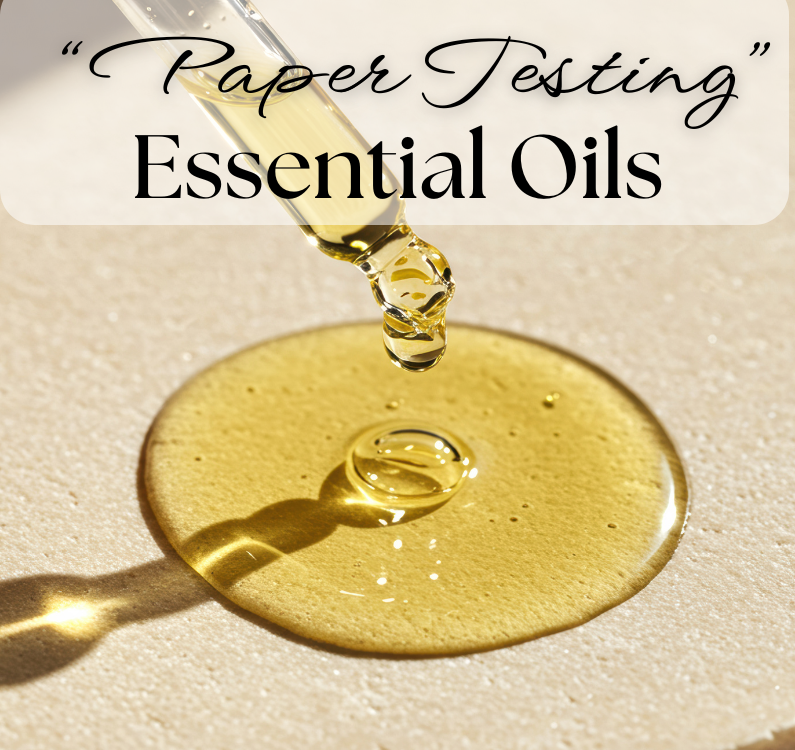The Paper Test for Essential Oils & Why It’s Not a Reliable Purity Check
Have you ever heard of the essential oil paper test? The theory is simple: put a drop of essential oil on a white piece of paper and wait. If it completely evaporates, it’s considered pure. If it leaves a greasy mark, the idea is that the oil has been diluted with a carrier oil and is therefore adulterated or lower quality.
While the paper test may sometimes reveal if an oil has been cut with a fixed carrier oil, it is far from a foolproof essential oil purity test. In fact, it fails to account for many factors that can make pure oils appear “impure” or allow adulterated oils to pass as authentic.
Why the Paper Test Fails
1. Heavy, pure essential oils won’t fully evaporate
Some oils naturally contain heavier, non-volatile components that linger even when they’re completely pure. Oils like vetiver, sandalwood, and patchouli will often leave a mark because parts of their chemical structure are not designed to evaporate. In these cases, the paper test gives a false negative for pure essential oils.
2. Modern adulteration can pass undetected
The paper test can only detect dilution with fixed carrier oils such as coconut oil or jojoba oil. Skilled adulterators may instead use synthetic aroma chemicals, natural isolates, or even oils from different plant species to stretch or alter an essential oil. These adulterants can mimic the evaporation behavior of authentic essential oils, allowing them to “pass” the paper test despite not being pure.
3. Evaporation rates differ between pure oils
Not all pure essential oils evaporate at the same rate. For example, citrus oils like grapefruit typically evaporate quickly because they contain lighter molecules, while oils like lavender have a moderate rate, and resinous oils such as frankincense evaporate slowly. Comparing evaporation between oils without accounting for their natural chemistry can lead to false assumptions about purity.
4. Cross-species adulteration leaves no visual clues
If a bottle of Boswellia carterii (frankincense) is mixed with another species of frankincense, it may still evaporate in the same way as the pure oil. The paper test can’t detect this kind of botanical substitution, even though the chemical profile — and therefore the oil’s properties — has changed.
A Better Way to Test Essential Oil Purity: GC/MS Testing
The only reliable way to confirm authentic essential oils is through Gas Chromatography–Mass Spectrometry (GC/MS) testing performed by a chemist experienced in essential oil analysis. GC/MS is the gold standard because it:
-
Separates the oil into its individual chemical components for precise measurement.
-
Detects synthetic additives, natural isolates, and cross-species adulteration.
-
Identifies signs of oxidation or degradation.
-
Verifies that the chemical profile matches the expected standard for that species and origin.
A GC/MS report is essentially a chemical fingerprint of the oil, offering proof of purity that no home method — including the paper test — can provide.
Final Thoughts
The paper test can sometimes spot carrier oil dilution, but it is not an accurate or complete way to determine essential oil purity. It can falsely flag pure oils as adulterated and completely miss sophisticated forms of adulteration.
If you truly want to know how to tell if an essential oil is pure keep in mind that batch-specific GC/MS test results are the way to go. When it comes to your health, your wallet, and the integrity of your aromatherapy practice, trust scientific testing — not paper stains.
Paper Test vs. GC/MS Testing for Essential Oil Purity
| Feature | Paper Test | GC/MS Testing |
|---|---|---|
| What It Does | Places a drop of essential oil on white paper to see if it evaporates without a stain. | Separates oil into its chemical components for precise identification. |
| Detects Carrier Oil Dilution | Sometimes, if a fixed oil is used. | Yes — can confirm and measure exact amount. |
| Detects Synthetic Additives | No. | Yes — identifies specific synthetic compounds. |
| Detects Cross-Species Adulteration | No. | Yes — confirms botanical species and origin. |
| Detects Oxidation or Degradation | No. | Yes — reveals signs of age or poor storage. |
| Accuracy | Low — prone to false positives and false negatives. | High — considered the gold standard for essential oil purity. |
| Expertise Required | None. | Must be performed and interpreted by a chemist knowledgeable in essential oils. |
| Best For | Quick visual curiosity check (not proof of purity). | Reliable, scientific confirmation of pure and authentic essential oils. |








